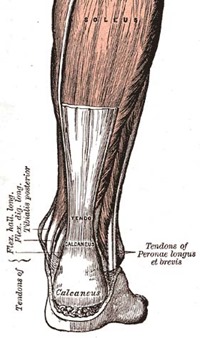 The Achilles tendon is a large tendon that attaches the calf musculature to the calcaneus at the back of the foot. When it comes to running injuries, those that affect the Achilles Tendon injuries are troublesome in that they can be chronic and difficult to treat.
The Achilles tendon is a large tendon that attaches the calf musculature to the calcaneus at the back of the foot. When it comes to running injuries, those that affect the Achilles Tendon injuries are troublesome in that they can be chronic and difficult to treat.
One of the first steps taken in the treatment of Achilles tendinopathy is typically an exercise regimen that aims to eccentrically load the tendon. This typically consists of sets of straight leg and bent leg heel drops at the edge of a step. Dr. Håkan Alfredson pioneered this technique, and a few years ago I listened to a podcast interview on BMJ Talk Medicine in which he describes how he developed his version of the technique which emphasizes painful eccentric heel drops. It’s actually a great story about the lengths a runner (Dr. Alfredson himself in this case) will go to return to the sport, and I won’t give it away the details here (you can listen below). I’ve been meaning to share this podcast here for a long time, and was reminded to do so after recently chatting with a friend and former colleague whose running career was halted by a chronic Achilles injury.
In the podcast Dr. Alfredson also discusses specific eccentric loading protocols for mid-tendon vs. insertional pain, other treatment options for Achilles tendinopathy should conservative management attempts fail, the dangers of cortisone injections in managing pain from AT, and a particularly interesting observation on the possible role that the plantaris muscle might play in some cases of medial Achilles pain.
If you’re not familiar with the plantaris, it’s an interesting muscle because the muscle belly is small and the tendon is very long and its insertion is variable, typically attaching either into the Achilles tendon or onto the medial calcaneus. What’s more, the plantaris is actually absent in some humans (~7% lack it according to this study). In contrast, it is a fairly large muscle in the cats I used to dissect with my students in A&P lab. I found Alfredson’s discussion of the plantaris interesting because it’s another example that highlights human variability and how that might influence individual injury risk.
Anyway, enough of an intro. If you’re interested in this subject, I encourage you to listen to the podcast:
And for anyone interested in what these eccentric loading exercises look like, here are a few videos (if you currently suffer from an Achilles injury, please see your doctor or therapist for proper diagnosis before attempting this as treatments differ for different types of Achilles injuries):
Straight legged heel drops:
Bent-knee heel drops:















His protocol got me back to running after months of suffering from A.T. I still do the heel drops every single day, both straight and bent leg!
I’m just recovering from Achilles tendinopathy and the heel drops have helped so much. But this injury is a tough one to overcome. Looking forward to listening to the podcast and get more info. Thanks for sharing.
Thanks for sharing, Peter. I have bee suffering from this for some time now and the heel drops do help. I will listen to the podcast shortly.
Cheers!
I at AT for 2 years (mid-portion, with a bulge that was sensitive to touch). It took 2 years, but I’m 100% recovered due to the eccentric heel drops (the only thing that worked). I did the protocol twice – the 1st time I built up to 40 add’t lbs in a backpack – I got halfway there that time. The 2nd time, I only did the exercises once/day (3 sets of both straight and bent leg), but increased to 70lbs of add’t weight — that was the cure for me…I ran thru the injury, as it didn’t make it worse to run (assuming I cut a ‘v’ in the heel of my shoe)…
So one of the guys is doing the exercises in an Asics shoe…usually a 10mm offset shoe. Does being on a 10mm offset plane from a regular flat surface affect the exercise and the persons loading? A flat shoe would not position the body in a premature plantarflexed position which doesn’t allow a natural amount of hallux or ankle dorsiflexion. Thank you to those companies who make flat designs.
I’ve got insertional Achilles with a charming bulge. Physio gave me drop off stairs exercises with straight leg. What could the reason for this differing from Prof A’s protocol be?
Thanks for this. Excellent post.
Quick question.
As you aren’t supposed to go below horizontal, why is the exercise done on a step (see video)? Surely, if it were done on the floor, there would be no chance of over-doing it and dropping too far. Any thoughts?
Alfredson’s classic approach described in his 1998 paper is to go below horizontal all the way down to end range. Some clinicians believe this may be too aggressive initially depending on patient, age, duration/frequency/intensity of symptoms, etc. But to answer your question, yes Alfredson wants you to go below the horizontal on the lowering (eccetric) portion of the exercise.
It is an exciting time in the world of tendon pathology! Alfredson first published on eccentric training in a classic 1998 study and I have been prescribing these for years now. Alfredson’s one-size-fits-all eccentric exercise treatment protocol is starting to be phased out in sports medicine as new science comes along. Don’t get me wrong – eccentrics are an important component of rehab and ALOT of patients got better that I used this approach with, but there were also a number who did not get better. In fact, up to 45% of Achilles tendons don’t get better (Malliaris et al 2013). Other approaches being studied are Eccentric-concentric progressing to eccentric (“Silbernagel combined approach”) and eccentric-concentric isotonic Heavy Slow Resistance (Kongstaand approach – although he has mostly studied patellar tendons). Just remember eccentrics are not the end all-be all! Check out more recent podcasts on the Physio Matters Podcast (Seth O’Neill episodes 6 and 11), Physioedge podcast (episode 5 with Jill Cook and episode 23 with Dr. Peter Malliaras). One of the biggest problems right now is we don’t have research that randomizes patients into separate groups (ie. 200 patients with Achilles tendinopathy that get randomized to 3 groups: Alredson eccentrics, Silbernagel combined approach, and Kongsgaard Heavy Slow Resistance approach) and then follows these patients to se who has the best outcomes. I’m a sports PT with specialty interest in foot/ankle and tendinopathies – no disclosures.
I was going to start the protocol, do you have to stop running during the 3 months, or can I continue my normal activities ?
Best to ask a therapist familiar with your case as each case is a bit different.
Hi, can you advise if there are any age restrictions to the Alfredsons Protocol? I’ve heard that it shouldn’t be used by those older than 55. Any thoughts on this please?